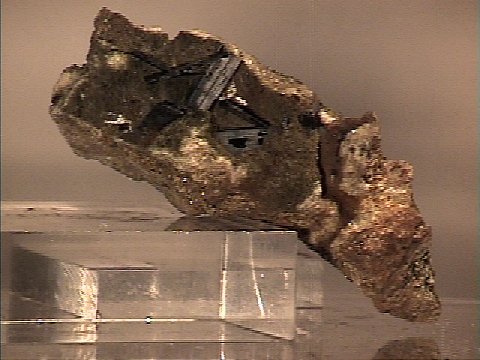 The Mineral MANGANBABINGTONITE
The Mineral MANGANBABINGTONITE
- Chemistry: Ca2(Mn, Fe)FeSi5O14(OH),Calcium Manganese Iron Silicate.
- Class: Silicates
- Subclass: Inosilicates
- Uses: Only as mineral specimens.
Specimens
Manganbabingtonite and babingtonite contain both divalent (+2) and trivalent (+3) iron ions. There is a difference in the size of these ions with the trivalent iron being larger. In manganbabingtonite and babingtonite these ions are segregated in the structure because of their differing sizes.The formula is written to show this relationship. The substitution of manganese only occurs with the divalent irons, since they are of similar size.
The differing charges on the irons causes a very weak magnetism that might turn the needle ofa compass. This can be very diagnostic since these two minerals can appear very similar to many other black, monoclinic, submetallic minerals. The magnetic effect is greater in babingtonite because it has more divalent irons.
PHYSICAL CHARACTERISTICS:
- Color is brown to black.
- Luster is vitreous, submetallic to dull.
- Transparency: Crystals are generally opaque but thin crystals or splinters can be translucent.
- Crystal System is triclinic; bar 1
- Crystal Habits include short stocky prismatic crystalsor tabular to platy forms.
- Cleavage is good in one direction and perfect in another, these are pinacoidal but are at near right angles to each other giving the appearance of rectangular prisms.
- Fracture is uneven to subconchoidal.
- Hardness is 5.
- Specific Gravity is approximately 3.5 - 3.6 (somewhat above average for translucent minerals)
- Streak is brown to gray.
- Other Characteristics: Sometimes very weakly magnetic.
- Associated Minerals are galena, sphalerite, diopside, hedenbergite, garnets, axinite, babingtonite, polylithionite and calcite.
- Notable Occurrences include Santa Teresa Mountains, Graham County, Arizona, USA and Rudnyi Kaskad deposit, Sayan, Russia.
- Best Field Indicators are crystal habit, color, locality, associations, cleavage and luster.


